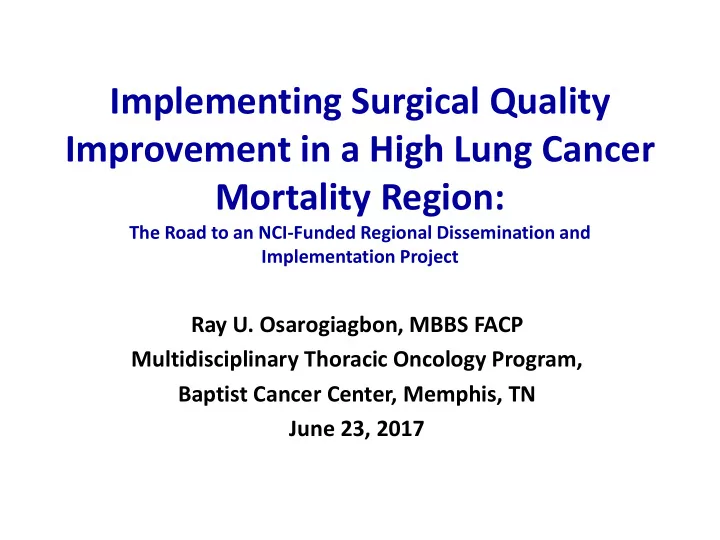

Implementing Surgical Quality Improvement in a High Lung Cancer Mortality Region: The Road to an NCI-Funded Regional Dissemination and Implementation Project Ray U. Osarogiagbon, MBBS FACP Multidisciplinary Thoracic Oncology Program, Baptist Cancer Center, Memphis, TN June 23, 2017
The Challenge: US Lung Cancer Death Map
Origins… • Serendipity: MMA-QSR • Every challenge presents an opportunity… every opportunity re-presents a challenge.. • Putting together a study team: rag-tag volunteer army- residents, fellows, medical students…. • Pilot studies- critical insight • Contextualization of data: loop up to national and international data
Critical Insight #1 Attainment of NCCN Criteria MMA-QSR Quality of surgical resection for non-small cell lung cancer in a US metropolitan area. Allen, Farooq, O’Brien, Osarogiagbon. Cancer 2011.
Nodal Staging: the Key Predictor of Survival 5-year Survival Rate Clinical Stage Pathologic Stage N0 50 56 N1 39 38 N2 31 22 N3 21 6 Rusch et al. J Thorac Oncol 2007; 2:603
Critical insight #2: Contextualizing the quality gap… • How big is this problem? • How widespread? • Are your findings, insights, etc generalizable?
Pathologic Nodal Staging Quality Gaps pNX survival mirrors pN1, not pN0 SEER 1998 - 2002 Overall Survival (no wedge) 1.00 0.75 Mediastinal Lymph Node Examination and 0.50 Survival SEER 1998 - 2002 1.00 0.25 p<.001 0.00 0.75 0 2 4 6 8 10 12 Hazard Ratio for Death in pN0 in relation to Time(years) Number at risk 0.50 number of lymph nodes examined pn_status = PN0 24200 14854 8685 4801 2268 574 0 pn_status = PN1 6795 3359 1675 811 376 94 0 pn_status = PNX 2319 1246 690 405 179 36 0 14% survival difference! 0.25 PN0 PN1 Lung Cancer Specific Mortality PNX 1.2 0.00 0 2 4 6 8 10 12 1 Osarogiagbon and Yu. Ann Thorac Surg 2013;96:1178-89. Time(years) Number at risk No MLN examined 7711 5420 4071 3210 1954 486 0 .8 MLN examined 4638 3435 2626 2152 1241 285 0 No MLN examined MLN examined .6 Osarogiagbon and Yu. J Thorac Oncol 2012;7:1798- .4 1806 0 2 4 6 8 10 12 14 16 18 20 22 24 26 Number of LN examined 95%CI Hazard ratio Smoothed line Osarogiagbon, Ogbata, Yu. Ann Thorac Surg 2014;97:385-93. ‘All animals are equal, but some animals are more equal than others’’ - George Orwell, ‘Animal Farm’.
Solving problems, not another Jeremiad!
Who’s going to give you twenty nodes? Number of Lymph Nodes Examined in ‘Node Negative’ Lung Cancer Resections: SEER 1998-2009 OR team: Hilar and mLN; Correct specimen labeling; Secure transfer to path lab Osarogiagbon and Yu. Ann Thorac Surg 2013 Pathology team: Intrapulmonary LN retrieval, thorough examination of all specimens, correct, comprehensive pathology report
Surgical Intervention • Lymph node specimen collection kit. Osarogiagbon, Robbins, et al. Ann Thorac Surg, Dec 2013
Stakeholder Recruitment • High-level hospital administrators • Thoracic surgeons • Pathologist • CV surgery OR staff
Study Outline
Meeting all four NCCN criteria The number of NCCN criteria met 1.00 1.00 Less than four NCCN criteria All four NCCN criteria 0.75 0.75 0.50 0.50 0.25 P<0.001 p<0.001 0.25 0.00 0 1 2 0 50 100 150 Months after surgery 0.00 3 4 Number at risk nccn_criteria = 0 1892 782 204 0 0 50 100 150 Months after surgery nccn_criteria = 1 333 66 8 0 Adjusted hazard ratio of meeting all four criteria: 0.64 (0.50-0.80) #2190: NCCN Quality Parameters and Survival - Nick Faris, M.Div. #2190: Impact of NCCN Quality Parameters on Patient Survival - Nick Faris, M.Div.
Critical Insight #3: Dissecting out the role of pathologists…
Lobectomy Specimen Before and After Thin Section Dissection Protocol
Who’s going to give you twenty nodes? Survival implications: MS-QSR Discarded intrapulmonary lymph nodes in lung resection specimens …with metastasis Lymph nodes Ramirez RA, et al, J Clin Oncol 2012;30(23):2823-2828 . Smeltzer, Faris, Yu, et al, Ann Thorac Surg 2016;102:448-53 Survival implications: ACOSOG Z0030 Distribution of non-hilar N1 nodal count: ACOSOG Z0030 Osarogiagbon, Decker, Ballman, Wigle, Allen, Darling. Ann Thorac Surg 2016;102:363-9
Building a Multidisciplinary Research Team • Observation: identify a meaningful challenge. • Iterative reasoning: question everything about it. • Identify stakeholders, identify what’s in it for them, find a hook. • Collaborate, encourage ownership of the challenge, engender passion in team members. • Start where you can, start small, let the findings guide you. • But, keep grand direction/strategy in full view.
Acknowledgements • R01 CA172253. • Past and present members of ThOR , 2007 – 2016, especially – Nicholas Faris, M. Div: Overall program manager. – Matthew Smeltzer, PhD: Epidemiologist; head of stats core. – Meredith Ray, PhD: Statistician. – Lisa Klesges, PhD: Implementation Scientist, Psychologist. – Carrie Fehnel, BA – Cheryl Houston-Harris, BS – Wale Akinbobola, BA – Philip Ojeabulu, MBBS – Nibedita Chakraborty, MA – Fujin Lu, MSc – Xinhua Yu, MD PhD: Epidemiologist. – 54 general thoracic, cardiovascular, general surgeons – 36 pathologists and pathology assistants – Hospital administrators in the 14 hospitals in the tri-state MS-QSR
Recommend
More recommend